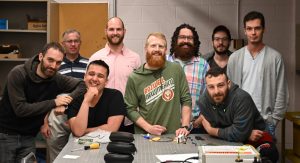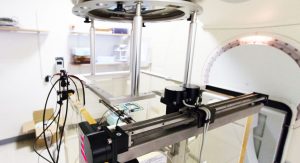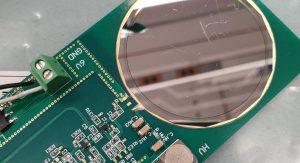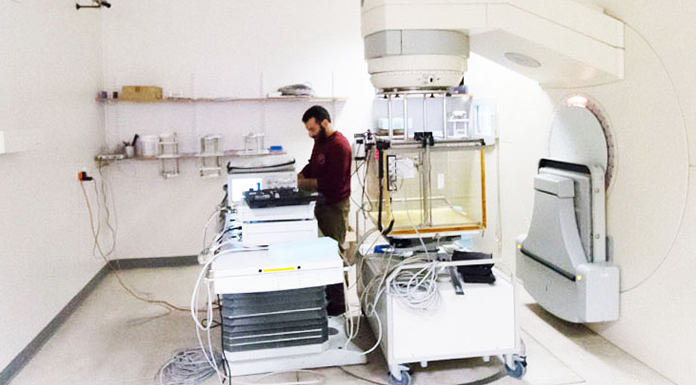New technologies developed at the University of Kansas are revealing radiation with unprecedented precision and giving a better understanding of the secrets of matter from the scale of the Universe to quarks.
Chris Royon, Foundation Distinguished Professor at the University of Kansas, discusses his team’s exciting work at Kansas University, from radiation and dosimetry to nuclear and particle physics. He had been member of the H1 experiment at HERA, DESY, Hamburg, of D0, Tevatron, Batavia, USA, and of ATLAS, CMS and TOTEM at CERN, Geneva, Switzerland, where he took on many responsibilities such as spokesperson of the ATLAS Forward Proton project. In 2018, he received the prestigious Humboldt Research Award in Germany in association with the University of Muenster and, in 2019, the High Energy Physics Prize of the European Physics Society as a member of the D0 Collaboration. Since 2016, he has also been Honorary Professor at the University of Gyongyos, Hungary.
We are pleased to meet him together with his group to discuss first the detector developments on which he is working as well as new important results in physics.
What work takes place in your group?
The group consists of seven graduate students and two post-docs, and we are developing new detectors to measure the time of passage of a single particle with picosecond precision. This will have tremendous applications not only in nuclear and particle physics but might also revolutionise the measurement of radiation and dosimetry.

This is quite interesting. Can you say a few words about the techniques used in high energy and nuclear physics as well as for the applications in medicine and cosmic ray physics?
The basic idea is quite simple. We use fast silicon sensors, in particular Low Gain Avalanche Diodes (LGADs), that produce a signal of a few nanoseconds when a particle goes through them. In Kansas, we developed a new method and electronics that amplify the signal and allows its digitisation at high frequency; then, interpolating the sampled points, we can reconstruct the full signal.
Traditional methods were only acquiring the maximum or the time duration of a signal, whereas we can reconstruct it fully. At the Large Hadron Collider at CERN, Geneva, Switzerland, similar technologies are being used in the design of the future upgrades of experimental apparati to measure time-of-flight or particles produced during a collision.
The electronics were developed and built in Kansas. What are the specificities and the advantage of your approach?
Regarding read-out board for solid state sensors, while testing silicon sensors for applications for the Large Hadron Collider, we realised that we could not find a relatively simple and easy-to-use board to characterise the sensor. Therefore, we decided to start our own development and we produced several versions of the board shown in Fig. 1.
Nicola Minafra, from the University of Kansas, says that the idea behind this board is that, once a sensor is installed, it is possible to connect the board directly to a power supply and to an oscilloscope to read out the signal, focusing on the characterisation of the sensor, instead of having to develop dedicated read-out electronics. This is extremely useful for any application. The amplifier is designed with fast timing detectors in mind, but it is general enough to be used with traditional silicon sensors, or with LGADs, or even with diamond detectors. Moreover, thanks to its reliability and flexibility, this amplifier was used as a base for many of our projects.
This design was submitted for a patent: patents.google.com/patent/WO2019232172A1/
One of the applications of these detectors is to measure radiation for the medical treatment of cancer with unprecedented accuracy. As an example, our team tested our detectors at St Luke’s University hospital in Dublin.
You mentioned some radiation tests performed at St Luke’s hospital in Dublin with your team. Could you explain why these tests gave world-leading results concerning dosimetry and why they are very promising concerning dose measurement? Furthermore, the medical application concerning the dose measurement during cancer treatment with proton beams seems to be fundamental for everyday life. How does it work and what level of precision can you obtain on the radiation dose received by patients?
Concerning dosimetry applications for medical facilities, a particularly interesting aspect of timing detectors is that they produce a signal that is extremely fast. For example, the signal generated in one of our prototypes at the passage of a single particle is only a few nanoseconds long. This allows us to be able to quickly count large numbers of particles, up to a few hundreds of MHz. One of the natural applications for this is dosimetry for cancer therapy using radiation. In fact, being able to literally count all particles that are used for the treatment gives an unprecedented precision on the measurement of the delivered dose.

Furthermore, these measurements can be extremely fast (just a few microseconds) while present techniques operate with integration times of several seconds, making the analysis of the fine structure of the beam impossible. Knowing the precise time distribution of the radiation pulses can lead to a breakthrough in radiation therapies, as already proved by flash radiotherapy. For example, in one of our recent publications,1 we demonstrated how it is possible to use single particle detection to monitor a radiotherapy beam at St Luke’s hospital. Not only we were able to reproduce the dose measurements performed with traditional radiation detectors (an ion chamber), but we were also able to precisely measure the structure of the pulses. In Fig. 2 and Fig. 3, we show a view of our radiation detectors installed inside the medical accelerator.
How do you see the long-term development of this idea and possibly industrial applications?
We are still in the early days of this R&D, but the first results are encouraging and, from a technical perspective, we do not foresee any complications. We are looking for partnerships with hospitals and medical researchers, as well as with companies to finely tune and adapt our technology.
These new ideas can definitely be applied to many applications where precise and instantaneous dosimetry is relevant, in nuclear power plants for instance. Coming back to another application, can you explain how the same approach can be used to measure cosmic rays in space?
In this application, the goal is to identify particles (is it an electron, a proton, or heavier heavy ions such as helium, lead, gold, etc?) and measure their energy using a compact detector that can be sent into space with a minimal cost.2 We use the same detectors as before and a ‘side effect’ of timing detectors to improve the capabilities of present detector technologies. These kinds of measurements are, of course, possible with present technology, but they require large and heavy detectors, to make use of calorimetry or time-of-flight, which would be extremely expensive to send into space.
We benefit again from the fact that we measure the full signal using our sampling method. The general idea is to have different layers of silicon detectors, and measuring the duration of the signal as well as the peak value in the given layer where a particle stops allows us to know the type of particle as well as its energy.
In fact, to produce a fast and clean signal, the front-end electronics has no time to ‘shape’ the signal. The downside is that the requirements on the electronics are quite challenging (high bandwidth and low noise) but, on the other hand, the output signal propagates most of the information ‘encoded’ in the sensor signal. Within our AGILE project, in collaboration with a team at NASA Goddard led by Dr Shri Kanekal and funded by NASA, we are exploiting this feature to recognise the type and to measure the energy of particles passing through a single silicon sensor. What we propose is using a single thin silicon sensor, as shown in Fig. 4.
This opens the possibility of having a cost-effective detector that can be easily integrated on board CubeSats. We are, in fact, planning the launch of the first prototype into orbit in the coming months.
What is the timescale of the Agile experiment and when will it be launched into space? And what would be the long-term applications be?
The launch performed in collaboration with the GENESIS company is foreseen for the beginning of 2022 with a simple version of the detector with only three layers of silicon. The idea is to show that we are indeed able to send this detector into space and receive the measurement back on Earth (this is the highest level of project at NASA). If successful, the second version of the detectors, with 16 layers or more, could be sent. This could have numerous exciting applications, such as measuring the amount of radiation with high accuracy that astronauts will receive when they go to Mars, for example, which is obviously a very high priority.

As you have already mentioned, the original development of this technique was for high energy and nuclear physics at CERN. Can you describe the activities of your group in this domain, especially at the LHC?
One of the main research goals of the physics programmes at the LHC is the discovery of physics beyond the Standard Model (SM) of particle physics. The SM is the quantum field theory of elementary particles, such as the electron, and their interactions, which are mediated by so-called mediator particles. It has become clear in recent decades that the SM is able to describe interactions at very small distances (high energies) to exquisite precision, on some occasions much better than we had anticipated. This is very exciting from the point of view of our mathematical modelling of the world, but it is incredibly frustrating for particle physicists! The reason is that we already know that the SM is an incomplete theory of interactions. For instance, there is not a single SM particle that could account for the observational evidence of dark matter in the Universe. Furthermore, while we have a good understanding of the quantum nature of electromagnetism and nuclear interactions, we do not have a well-established and experimentally verified quantum theory of gravity. Thus, one of the main goals at the LHC is to find smoking-gun hints of physics that may shed light on possible extensions of the SM.
In order to look for possible signatures of new physics at the LHC, we need to address every possible way that these new interactions can manifest in high-energy proton-proton collisions. Our group also works in the CMS and TOTEM Collaborations at CERN to explore reactions where protons interact electromagnetically. Thus, one can effectively have high-energy photon-photon collisions at the LHC, whereby the photons interact to produce energetic particles. As a result of the photon exchange, the protons may remain intact and scatter at small angles, where they can then be tagged in dedicated detectors known as Roman pots. This kind of production is very special.
Analysing this production was proposed for the first time by our group and was the reason these Roman pot detectors were used at the LHC.3
Cristian Baldenegro, a PhD student in the group, adds that these photon-photon collisions can be used to explore interactions that are otherwise impossible to probe in standard proton collisions at the LHC, where quark and gluon interactions dominate the interactions of interest. In these kinds of photon-photon interactions,4 we are sensitive to the presence of new particles much heavier than the energy scale that we can probe at the LHC energies via virtual quantum fluctuations, or with the propagation of graviton modes that receive enhancement from extra-dimensions. Pseudoscalars that are weakly coupled to the electromagnetic field, known as axion-like particles, can also be probed in photon-photon interactions. The latter are predicted in a number of extensions of the SM that consider spontaneous symmetry breakings.
Are there additional topics on which you are working at KU?
Our group at the University of Kansas is also deeply involved in the study of strong interactions in extreme conditions. The protons and neutrons, as well as heavy ions, such as the Pb ions at the LHC, are made of quarks and gluons, the elementary particles of quantum chromodynamics (known as ‘QCD’). We are studying very special interactions where the number of gluons in the proton or heavy ion gets very large. The vast majority of these gluons carry smaller and smaller amounts of the proton or heavy ion’s energy. An everyday analogy would be the metro in Paris, London, or Tokyo at rush hour – at this time, the metro would be completely crowded, which means that everything behaves as if there were a single global motion of the crowd and each individual does not move alone by themselves. Something similar occurs inside the proton or a nucleus, where the large number of gluons that are confined within them exhibit a collective behaviour.
This new domain of strong interactions is still unknown and might lead to new discoveries at the CERN LHC in collisions of protons and heavy-ions, or at the future Electron-Ion Collider to be built in the US at Brookhaven National Laboratory, close to New York.
In addition, the group had a leading role in the recent discovery of the odderon,5 an elusive three gluon compound that was predicted almost 50 years ago. The discovery was made possible by comparing elastic proton-antiproton and proton-proton interactions at Fermilab, Chicago, USA and CERN, Geneva, Switzerland, respectively. This is a fundamental discovery that probes the deepest features of quantum chromodynamics, the interactions between quarks and gluons that are the elementary building blocks of all matter6.
References
1. Performance of a low gain avalanche detector in a medical linac and characterisation of the beam profile
2. A novel technique for real-time ion identification and energy measurement for in situ space instrumentation
3. Anomalous quartic WW gamma gamma, ZZ gamma gamma and trilinear W gamma gamma couplings in two-photon processes at high luminosity at the LHC
4. Searching for axion-like particles with proton tagging at the LHC. Light-by-light scattering with intact protons at the LHC: from Standard Model to
5. Comparison of pp and p pbar differential elastic cross sections and observation of the exchange of a colourless C-odd gluonic compound
6. The discovery of the odderon
Please note, this article will also appear in the sixth edition of our quarterly publication.









